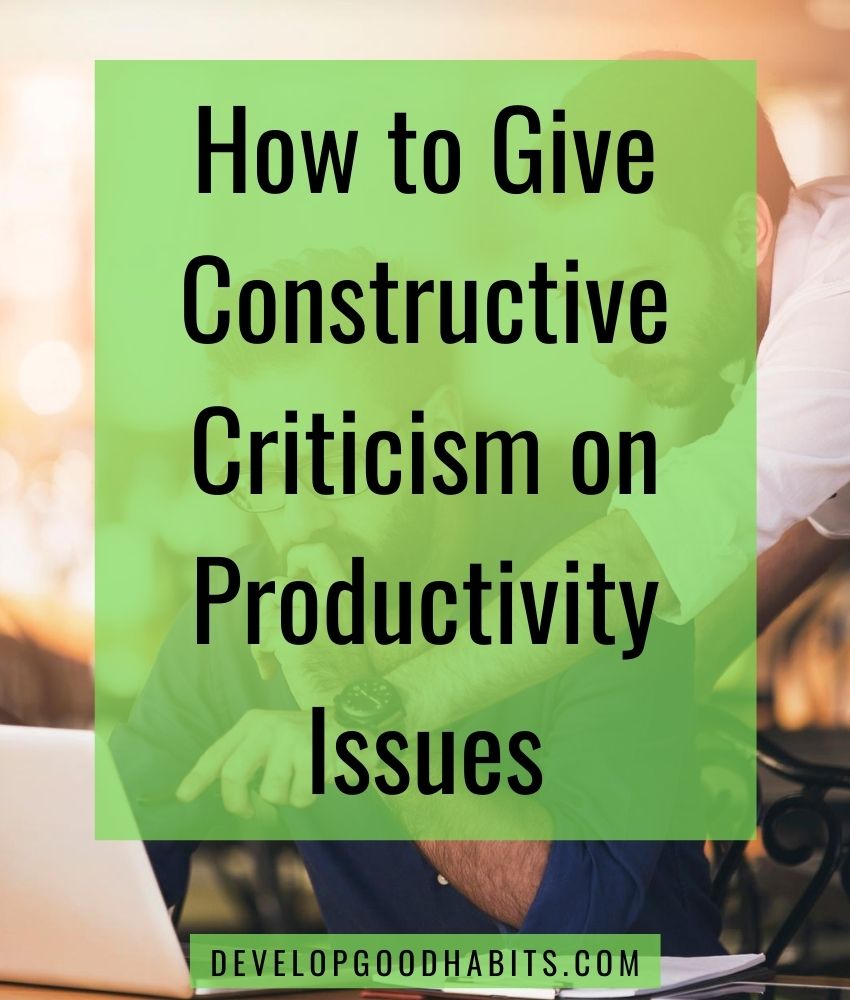There might be affiliate links on this page, which means we get a small commission of anything you buy. As an Amazon Associate we earn from qualifying purchases. Please do your own research before making any online purchase.
Receiving criticism can hurt.
…especially when it’s from your boss.
No matter how “supportive” it is intended to be, it’s often difficult to see past the negative component to criticism: the fact that you did something…imperfect.
I know I have spent hours ruminating over constructive criticism that was given to me at work, thinking everyone knew that I “got in trouble.”
But, the truth is, constructive criticism is not meant to be hurtful–and often, the person giving the feedback is trying their very best to make that clear because they know how the recipient may be interpreting the message (more on that in a minute).
But, if you look at the research, employees actually want to hear constructive criticism from their superiors. They believe that this type of feedback is essential to their professional development.
In fact, 92% of the respondents agree that if constructive criticism is delivered in the right way, they take it seriously and take corrective action, therefore improving their performance.
What’s interesting is that it’s the leaders who would rather not be a part of this type of conversation. Managers often feel uncomfortable talking to their employees about something that may be perceived as being negative and they report higher levels of stress when having to do so.
This means that the ability to offer constructive criticism is one of the integral characteristics of being a good leader, and a critical professional skill to have to increase your team’s performance and set you apart from other managers.
In this article, we are going to look at examples of constructive criticism for the workplace that are delivered in an effective way.
Hopefully, these examples will help you build the confidence you need to deliver this type of feedback without feeling hesitant. But first, let’s look some more at what constructive criticism is and why it’s important.
Now, setting goals and following through is a great way to avoid any type of criticism. So, take a few minutes to watch the video below and learn about SMART goals and the 21 examples you can use at work or in your business.
What Is Constructive Criticism?
Constructive criticism is honest and valid feedback that is offered with the intention of helping the recipient improve their work in some way in order to achieve a positive outcome.
It’s offered in a well-intentioned and friendly manner and includes both positive and negative points, making it a comprehensive and useful opinion.
What makes constructive feedback–well—constructive is that it’s easy to put into action. It comes along with specific, actionable ideas to make improvements to any issues that have been identified with your work.
Instead of just saying, “good job” or “it could be better,” this type of criticism gives clear recommendations on how you can implement the feedback.
Giving and receiving constructive criticism is important because it is the gateway to growth. Without hearing the honest opinion of other people, you may never know the ways in which your work could be tweaked or improved.
Constructive criticism helps people learn first-hand how they can increase their chances of success, which makes it pretty invaluable in the long-run.
In the workplace, constructive criticism can help employees gain a better understanding of the company’s expectations and the actionable steps they can take to meet and exceed them.
This exchange of information benefits everyone because it helps managers get to know their employees, it gives employees valuable guidance to be successful at work, and the organization gains improved productivity in its workforce.
In order for the delivery of constructive criticism to be effective, it is important to have strong interpersonal communication skills. These skills will help you deliver the criticism using a friendly, soft tone and positive language, which will improve its reception.
Your tone of voice can make a huge difference in how well the criticism is received–and can often communicate even more than your words do.
Let’s take a look at 9 examples of how this can be done effectively and in a way that is conducive to a positive working environment.
Careless Errors/Work Isn’t Adequate

1. Avoid Making it Personal
When you’re offering constructive criticism, you don’t want it to sound like it’s an attack on the person in any way. Instead, you want to focus on the specific professional issue that you’re trying to help them improve.
Let’s say you have an employee whose presentations are boring and dry, which you know can be a quick turn-off for potential clients.
In this case, you don’t want to lead with, “Your public speaking skills are pretty bad” because that sounds like a personal attack that will likely put someone on the defense. Instead, try something like this:
“I think your presentations could be more engaging if you incorporated some visuals or set aside some time to interact with the listeners in some way. One thing I thought was really effective was that time you used graphics to clarify your statistical data–try to add in more layers of that nature to your speeches.”
Not only does this put the focus on the presentation rather than the presenter, it also offers some actionable steps the person can take to improve the issue.
2. The Feedback Sandwich
This method of giving constructive criticism helps ensure that you include positive feedback along with your suggestions for improvement. Doing this involves three components:
For example:
“I really appreciate your dedication to timeliness when it comes to turning in your monthly reports. As you know, we have had some issues lately with reports being turned in late, so your respect for deadlines certainly hasn’t gone unnoticed.
However, I have seen some errors in your reports lately, including inaccurate data as well as typos and grammatical mistakes. While timeliness is a critical factor, we also need to make sure that the reports are accurate and are written in a way that reflects positively on our organization.
I know you’re a good writer, so I’m sure if you take the time to slow down just a bit, your reports will be a model for how everyone’s monthly reports should be done.”
The feedback sandwich is an effective way to offer constructive criticism because when you lead with a positive comment, you’re letting the person know you’re on their side by recognizing what they’re doing right.
This will help the receiver be more open to considering your suggestions for their improvement. And finishing on another high note will reinforce that you’re coming from a positive place and genuinely want to help this person succeed.
Productivity Issues

3. Be Supportive
If you have an employee whose productivity has declined lately, there is likely an underlying reason–and you don’t want to make any assumptions.
Being supportive when giving constructive criticism ensures that the recipient knows that their success is in both of your best interests, and your aim is to give them any resources that they may need to help them along the way.
In fact, studies show that people who feel emotionally supported when they’re receiving constructive criticism are more motivated to expand their thinking and make measurable changes in their work.
Show the recipient that you have confidence in their ability to resolve the issue at hand.
For example:
“I wanted to check in with you and see how things have been going. I know you’re typically one of my most productive team members, but lately it seems like you’ve been a bit disengaged and your numbers have dropped. What can I do to help you get back on track?
I know what you’re capable of, and I’ve always been impressed with your work. Let’s schedule a meeting to go over your goals and responsibilities to make sure we are still on the same page.”
(Check out this post on how to help your employees create goals.)
This is supportive for a few reasons. First, you’re telling the employee that you’re confident in their abilities and recognizing that this lack of productivity is a change from the norm.
Secondly, you’re telling the employee that you want to work together to uncover a solution and you’re willing to meet them halfway in order to keep them happy at work.
4. Offer Actionable Advice
When giving constructive criticism, make sure to say something that the recipient can take action on right away to make a positive difference in their performance. If possible, talk about strategies that you can both implement to make headway toward improvement.
For example, if an employee is clearly having trouble with time management and prioritizing tasks because their productivity is low, you could offer them one of these worksheets or create a spreadsheet that outlines tasks in order of importance or level of urgency.
Teaching your employees about the Eisenhower Matrix is also a great resource to help them with prioritizing their tasks.
The employee would then be held accountable for completing their work and ensuring they’re meeting your expectations by checking off tasks as they go and then having a manager monitor their progress and improvement.
Here is an example of constructive criticism that offers actionable advice:
“I’ve noticed lately that some critical assignments have been falling through the cracks, while some less important tasks are taking up a lot of your time. Let’s figure out how we can improve your productivity while still maintaining your high quality of work.
How would you feel if we created a plan that prioritized your tasks? This will allow us to monitor your progress and what you’re working on. If a question arises on what you should work on once a task has been completed, you can refer to the plan to identify what comes next to help you gain clarity.”
This example offers advice along with potential resources that the employee could start using immediately to help fix the problem. Giving actionable advice allows the recipient to focus on goals for themselves so they can improve, rather than ruminating on their faults.
5. Recognize They Probably Already Know There’s an Issue
If there has been a recent decline in someone’s productivity, chances are that they already know that. This is especially true if it’s one of your higher-achieving performers, which also means that they’ve likely already beaten themselves up about it a bit.
You don’t want to add onto their disappointment in themselves, so make this more of a conversation about setting more reasonable goals than a suggestion that they aren’t doing their work. You could say something like:
“I admire the fact that you keep high expectations for yourself, and the progress you made on each of your projects has been valuable for the whole team. However, when you take on so much, I worry that each project isn’t getting the attention that it deserves.
What would you think of cutting back a bit and focusing exclusively on one or two things this quarter? I think if we make more attainable goals for you, you may feel less overwhelmed.”
Wording constructive criticism in this way makes it sound more like a two-way conversation in which you’re looking to collaborate with the person to not only make them feel more comfortable with their workload, but also to make sure things get done well.
Tardiness

6. Be Prompt in Giving Constructive Criticism
Studies show that time is of the essence when you’re delivering constructive criticism. If left unaddressed, issues can progress and compound to much bigger problems than they were when they started.
If you have an employee who has been late to work more than once recently, you can address this without being confrontational. Remember, you don't want to make any assumptions and you want to be supportive.
“I’ve noticed you’ve missed the first half of our last two staff meetings and I’m concerned you may be missing some important topics or announcements that could ultimately impact your performance.
I know we all have things going on outside of work–and if there is something going on that you need to talk about, you know that I’m here to listen. But, moving forward, I would like for you to be a bit more conscious of the time and the importance of getting into the office when everyone else does.”
This isn’t something that you would want to linger before addressing. First, the employee could start to think that this is acceptable behavior because no one is telling them otherwise, which could lead to them eventually coming in even later.
Secondly, if the employee is late because they have something else going on for a few weeks in the morning, it still needs to be acknowledged that they need to clear any outside responsibilities with you before missing work.
Not only should this be done out of respect, but it’s also a safety issue, as you should know where your employees are during working hours.
7. Focus On One Thing at a Time
Once you’ve gotten your nerve up to have a meeting with your employee to give them some feedback on their recent performance, it may be tempting to take that chance to pile it on and give all of the bad news at once.
Don’t do that.
Focus on one thing at a time so the recipient can process the message, respond in whatever way they feel necessary, and ask questions. Giving a lot of feedback at once will inevitably feel like an attack–and, according to Clifford Nass, a professor at Stanford University, people can really only absorb one piece of criticism at a time.
Adding on to the last example, you can wrap it up by saying something like:
“Do you have any questions? Let me know if there is anything I can do to help your mornings be a bit smoother.”
Just leave it at that and address other issues as they arise.
Unprofessional Behavior

8. Avoid Making Generalizations
One easy way that people often use to separate themselves from the bad news that they’re bearing is to make generalizations such as, “Everyone has noticed…” or “Everyone’s telling me…”
These generalizations can quickly make someone feel like the team is ganging up on them and gossiping behind their back.
If you’re giving someone constructive criticism, you need to take ownership of it and not blame it on “everyone” else. And remember to keep it positive because positivity will breed positivity.
“I’ve noticed lately that when I come to your office to touch base about something, you’re not in there. It is very important for your productivity to take appropriate breaks during the day to give your mind a rest, but I can’t help but notice how often you’re visiting with other people in their offices.
I want our team to have a bond and get along well, but spending too much time socializing during the workday is unprofessional. I know when my door is shut, I’m usually trying to concentrate on my work and don’t want to be interrupted to talk about irrelevant topics, and I assume this is the case for others as well.
Please try to limit your socializing at work to designated break times so both you and your team can use your time efficiently when you’re in the office.”
While this mentions other members of the team, it’s just to show how the recipient’s excessive socializing can have a negative impact on everyone.
There are plenty of “I” statements in this example, which shows you’re taking personal responsibility for the criticism, which won’t leave the recipient running out of your office to other employees asking “who said something to the boss?”
9. Follow Up
No matter what your constructive criticism is about, it’s always important to follow up after giving the recipient some time to improve the issue at hand. It takes a lot of effort to effectively provide constructive criticism, so don’t let it be a one-time conversation that you never revisit.
Follow up by showing appreciation when you see improvement along the way to further demonstrate that you’re on their side and that you care about their success. This will also give the recipient an opportunity to ask any questions that they might come up with once the criticism has had some time to sink in.
Providing positive reinforcement can also motivate the recipient to keep the initial conversation in mind, which will hopefully prevent them from falling into old habits.
Finally, it will solidify that you were serious about the concern and you’re keeping an eye out for the agreed upon change. Let’s look at what you could say when following up with you dull public speaker from the first example:
“John, I wanted to just quickly touch base about our conversation from a few weeks ago and let you know that your genuine effort to engage people while giving your presentations has made a profound impact.
Have you noticed that clients are staying much longer after your presentations to get more information? I’m receiving more follow-up inquiries from people who have attended your presentation and we’ve had a 17% increase in contracts so far this quarter. How are you feeling about it?”
This follow up serves a few purposes. It acknowledges that John made an effort, it quantifies the positive impact that his efforts have had on the company, and it invites John to offer feedback of his own. This has turned a potentially one-way moment of criticism into a collaborative effort.
If some time has passed and you haven’t seen an improvement with the issue, following up will allow you an extra chance to provide additional training or tips if you can.
Or, if the recipient has completely disregarded the constructive criticism you gave them (or even worse, made the issue even more of a problem than it was to begin with), then this might be the time to either change your approach or initiate disciplinary action.
Final Thoughts on Constructive Criticism in the Workplace
Constructive criticism is a useful tool for guiding your team in the right direction or for diverting problem performance.
Mastering the delivery of constructive criticism takes practice, and it won't always go over as well as you hope–even if everything goes as planned on your end. But offering constructive criticism is an essential element to the success of your team and your organization as a whole.
Make sure to consider how you would want to receive any constructive criticism before giving it out.
Is what you’re planning on saying potentially hurtful? Or have you incorporated some of the examples mentioned above to ensure the information will be taken to heart?
If you’re unsure how your constructive criticism will be interpreted, go back through the advice here to see if it checks all of the boxes.
And if you're looking for more tips to improve your workplace performance, be sure to check out these blog posts:
- 23 Good Work Habit Examples to Build a Successful Career
- 17 Simple Ways to Improve Your Work Performance
- 19 Leadership SMART Goals Examples for Your Workplace
Finally, if you want to take your goal-setting efforts to the next level, check out this FREE printable worksheet and a step-by-step process that will help you set effective SMART goals.

Connie Mathers is a professional editor and freelance writer. She holds a Bachelor's Degree in Marketing and a Master’s Degree in Social Work. When she is not writing, Connie is either spending time with her daughter and two dogs, running, or working at her full-time job as a social worker in Richmond, VA.


